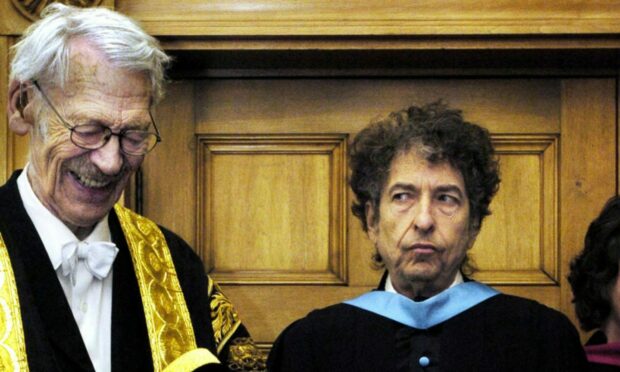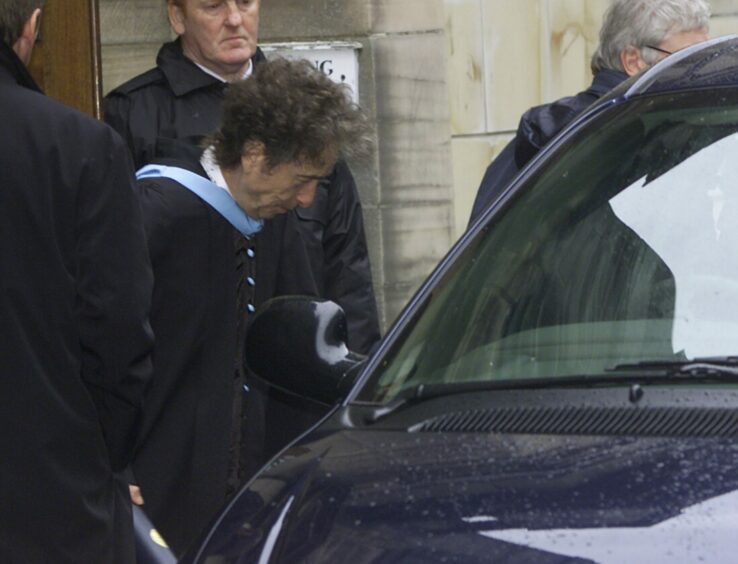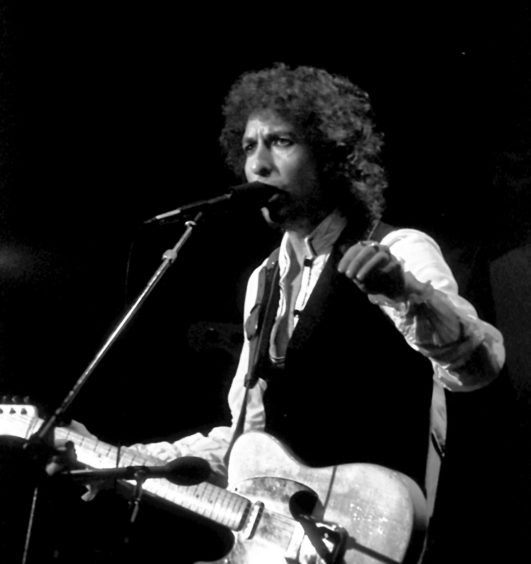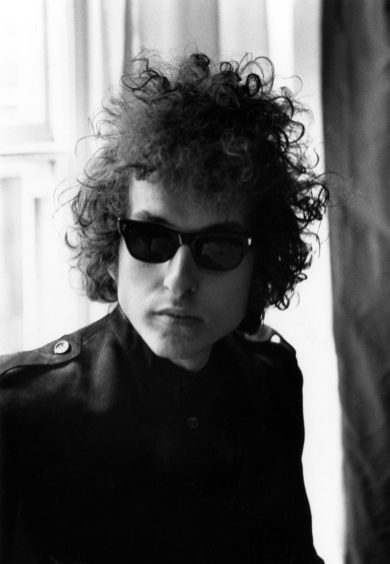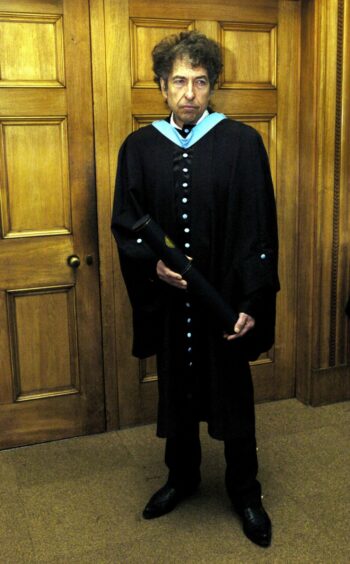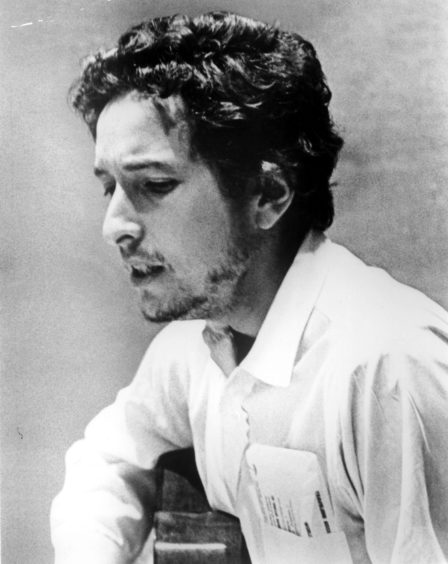He is one of the great troubadours of modern music; a man whose songs were as famous as those of The Beatles in the 1960s and whose legacy has been every bit as influential on future generations.
Yet, unlike the Fab Four, Bob Dylan has always preferred to let his work do the talking – with an aversion to publicity which has often made Greta Garbo seem garrulous by comparison.
So there was considerable excitement when it was announced in 2004 that Dylan, the composer of such timeless masterpieces as Like a Rolling Stone, Mr Tambourine Man, Lay Lady Lay, A Hard Rain’s A-Gonna Fall, Maggie’s Farm, Hurricane and Shelter from the Storm, had not only agreed to accept an honorary degree from St Andrews University, but was travelling to the ancient Fife institution to collect the award during an ongoing tour of Europe.
Would the maestro have a message for the students when he arrived at the ceremony in June? Would he speak about his love for the poems and songs of Robert Burns or his precious debt to Scottish folk artist Matt McGinn?
The answers, my friends, are blowin’ in the wind….but his presence at the prestigious occasion still sparked a media frenzy and led to some of Dylan’s fans venturing to the royal burgh in hope of seeing the iconic figure and even, praise be, hear him deliver a speech to his youthful audience.
However, he left through a side door immediately after the ceremony. Tight-lipped and as elusive as ever, he departed with the minimum of fuss and moved on to prepare for a brace of concerts in Glasgow later in the week.
It’s not often that university dons are left star-struck during these events, but there again, Dylan wasn’t prone to picking up any old prize. On the contrary, he had only accepted one previous honorary degree – from Princeton University in his homeland – and that had happened 34 years earlier in 1970.
So there was a tangible sense of something special happening when the members of the St Salvator’s Chapel Choir performed their version of Blowin’ in the Wind before he stepped up to receive his degree.
Fulsome tribute to a music legend
The man, born Robert Allen Zimmerman in 1941, knelt in front of chancellor, Sir Kenneth Dover, who performed the ceremony in Latin.
He was then tapped on the head with the university’s graduation cap and turned and bowed after gaining his degree, to cheers and applause from the audience.
At which point, Professor Neil Corcoran delivered a fulsome tribute to Dylan which put into context his contribution to music in the 20th century.
He said: “In one of his first concerts in New York in the 1960s, Bob Dylan said that he had recently been asked to contribute to a book about Woody Guthrie, the great folksinger, songwriter and political activist.
“He’d been asked: ‘What does Woody Guthrie mean to you in 25 words?’ And Bob Dylan said: ‘I couldn’t do it’. Instead, he read: ‘Last Thoughts on Woody Guthrie’, a tender poem about Guthrie and the spirit of American idealism.
“I feel similarly incapable when I am asked to say what Bob Dylan means to me in a few minutes. In fact, what I am here to say isn’t really what he means to me, but what he means to the University of St Andrews that we should have offered him the honour of a doctoral degree.
“It goes without saying his acceptance deeply honours us, and I really can’t say what a great privilege and pleasure his presence here is today.”
Prof Corcoran continued by saluting Dylan’s “magnificent songs” which he claimed would “last as long as song itself does”.
And he declared: “There are the early songs of political engagement, songs like The Lonesome Death of Hattie Carroll; songs inseparable from the history of the American Civil Rights movement.
“There are the revolutionary songs of the mid-1960s, songs that seem to well up out of nowhere, an electric nowhere of American turbulence, songs like Subterranean Homesick Blues and Mr Tambourine Man, Desolation Row and Like A Rolling Stone.
“And then there are, always, the love songs – of longing and desire, of hope and hopelessness, songs like Boots of Spanish Leather and Lay, Lady, Lay, Tangled up in Blue and Lovesick – songs that make Bob Dylan one of the great writers of the drama of human relationship.”
He finished with the message: “It seems appropriate that his second such degree should come from Scotland’s oldest university, since Scottish border ballads and folksongs have been the inspiration for some of his melodies, and his great song Highlands is an elaborate riff, or descant, on Robert Burns.”
Bob Dylan’s many links to Scotland
Many of the students at the ceremony wouldn’t have known much, if anything at all, about Dylan’s myriad links and connections to Scotland.
But they must have gained plenty of insight from Prof Corcoran’s words.
In the aftermath, some people spoke of their admiration for Dylan and their amazement that he had played a pivotal role in their big day.
Jennifer Laurens, a 23-year-old graduate in social anthropology, told The Courier: “This is a very special day for St Andrews.
“Considering that this is Bob Dylan’s second degree and that he had agreed to travel to Scotland, it makes it an achievement for us all.”
It didn’t matter to her or her friends and family that Dylan hadn’t addressed the throng. After all, what could he possibly have told them that was more uplifting and inspirational than the fact he was there at all?
That is one of his many talents. And his ability to retain his magic and mystique in an age where so many are pre-occupied with the lives of the rich and famous, helps explain why there will be sell-out crowds when he returns to Glasgow’s Armadillo venue for concerts on October 30 and 31 this year.
Bob Dylan was once asked what his songs were about and he replied: “Oh, some of them are about three minutes, some of them are about five minutes, and some of them, believe it or not, are about eleven minutes”.
Touché!
More like this:
Stuart Adamson: Could Big Country have been called The Rodeo Giants?
Why Dundee is a special place for Beatles icon Sir Paul McCartney
